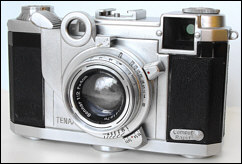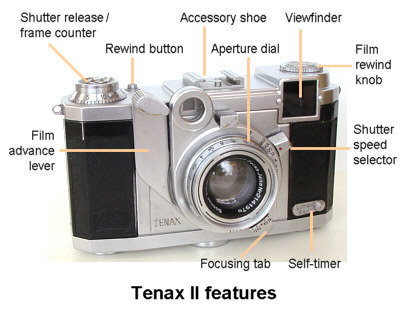
Zeiss Ikon
Tenax II: Square Is Cool
 This is one of the more curious cameras to
roll of the line from Zeiss Ikon. Perhaps responding to the popularity of the Robot cameras,
Zeiss Ikon produced the Tenax II. Like the Robot, the Tenax II
shot square photos (24mm x 24mm). This is one of the more curious cameras to
roll of the line from Zeiss Ikon. Perhaps responding to the popularity of the Robot cameras,
Zeiss Ikon produced the Tenax II. Like the Robot, the Tenax II
shot square photos (24mm x 24mm).
Oddly enough, the Tenax II was released on the market before the Tenax I.
Both cameras featured a front-mounted lever that advanced the film and
cocked the shutter, and both produced a square image. Beyond that, the
cameras were very different. The Tenax II is a more advanced camera with
interchangeable lenses, while the Tenax I used the Novar. Moving back in
time, the Tenax name was
used previously on plate-film camera from Goerz, which in 1926 was one of the companies
that was part of the merger that formed Zeiss Ikon. The Tenax name
reappeared on at least two other cameras. Zeiss Ikon wasn't shy about
reusing camera names from the products of its pre-merger companies or sometimes the
companies themselves, such as the Contessa, the Super Nettel, the Icar and
others.
The Tenax II is often seen these days with the f/2.8 40mm Tessar. I'm lucky
to have found one with the f/2.0 Sonnar, and I have to say that this
is a terrific lens. Although it has a small number of cleaning marks (fewer
than 10), the Sonnar can reproduce images with amazing crispness. The
interchangeable lenses are scarce and expensive. I wouldn't mind finding the
wide angle and telephoto, but I suppose I should want to consider a second
mortgage on the house to pay for them. In the meantime, I'll make do with the Sonnar.
I shouldn't say that "I'll make do with the Sonnar," because you might
think that this lens is somehow inadequate. Certainly, it's not even close
to that. Black and white shot through this lens have a wonderful feel to them.
Look at the samples, you'll get an idea of what I
mean. A roll of 24 will yield roughly 36 shots, while a roll of 36 gives
about 50 pictures.
 From
what I can tell, the camera uses a medium format Compur Rapid shutter,
complete with a self-timer mounted on the front of the body. Rangefinder
focusing is engaged by moving the tab on the bottom of the lens that swings
through a narrow arc. The tab has a small depth of field scale engraved on
the front. Another lever selects the appropriate shutter speed,
while the aperture ring is in the traditional spot. Because this is a leaf
shutter, the top speed is 1/400. And as with most Compur shutters, you have
to push the shutter speed selector harder than normal to set the 1/400
speed. The Tenax II is not flash synchronized. From
what I can tell, the camera uses a medium format Compur Rapid shutter,
complete with a self-timer mounted on the front of the body. Rangefinder
focusing is engaged by moving the tab on the bottom of the lens that swings
through a narrow arc. The tab has a small depth of field scale engraved on
the front. Another lever selects the appropriate shutter speed,
while the aperture ring is in the traditional spot. Because this is a leaf
shutter, the top speed is 1/400. And as with most Compur shutters, you have
to push the shutter speed selector harder than normal to set the 1/400
speed. The Tenax II is not flash synchronized.
The rangefinder system uses the Zeiss Ikon tried-and-true rotating-wedge
prism. It's not a complex system, and once calibrated it's highly accurate
and rarely falls out of calibration. The only real danger is damage to the
wedge prisms or separation of the main prism that sits under the top cover.
The overly large lever adjacent to the lens both advances the film and
tensions the shutter. The shutter release is in the
center of the film-counter dial. A smaller button on the top of the camera
is held down while rewinding the camera via the top mounted key that is roughly the same size as the film advance found on the Super Ikonta A.
Loading and removing film is similar to the Contax and Super Nettel. Turn
two "keys" on the bottom plate, and the back slides off. You can use either
the standard Contax film spool with a regular 35mm cartridge or you can use
a preloaded (self-loaded these days) Zeiss Ikon film cartridge with the film
spool or two Zeiss Ikon film cartridges (one loaded, one empty). Your
choice. The advantage to the Zeiss Ikon cartridges is that it allows you to
change film midroll without having to rewind. Remove the film and reinsert
later — advance the film two frames, reset the frame counter and you're back
in business.
Much like other Zeiss Ikon cameras, the Tenax II is very well made. The
choice of materials is first-rate, while the leather gives it a wonderful
elegance. The reticle is a bit tiny, which is typical of cameras from that era. The
unified rangefinder-viewfinder is suitably large, and focusing the camera is
very easy, regardless of conditions. I've used this camera at a concert, and
I had no problems focusing.
The camera is small and easy to slip into a coat pocket. I'm not so sure
about jeans, however. There is enough heft to it to keep the camera steady,
but it's not so heavy that you get tired of having it hang from your neck.
This camera is rapidly becoming one of my favorites. I don't know if it's
the square image, the easy operation or the great lens, but I get a higher
percentage of keepers with this camera than any other ... possibly more than
the Contax IIa (please, say it ain't so!).
As war began to spread across Europe, such luxury items as cameras
weren't deemed necessary to the war effort. Production of the Tenax II came
to an end after a very short two-year run and was not restarted after the
end of World War II. Nearly two decades later, Zeiss Ikon resurrected the
Tenax name for another camera, but it bore little resemblance to the the
Tenax II — in terms of look or function. The Tenax II remains one of the
finest cameras ever made.
Restoration notes
Like nearly all of the cameras that
I've owned, this one was no different in that it needed overhauled
before I could even think about using it.
The viewfinder was occluded by haze
and decades of grime. That meant removing the top deck and
cleaning inner and outer surfaces of the prisms and viewfinder
glass.
The camera also had some rather
unsightly irregular bumps under the leather. So those had to be
removed as well. The back has two holes, which are covered with
small square brass leaves. Naturally, those were covered with
green debris.
Next, the lens was dirty and had some light
cleaning marks. And
oil had to be removed from the aperture blades. To try to counter
the effects of the cleaning marks on the lens, I've taken to using a
multicoated UV filter. I think it helps, as does a lens hood.
Removal of the top deck is fairly
straightforward. The one thing I did was try to seal the front viewfinder
glass to prevent dust from entering. I used a bit of foam, which I suppose
in 20 years will either crumble or turn to goo. Perhaps at some point I'll
replace it with some black yarn.
The shutter was running
smoothly, including the self-timer. In all, I spent about four
hours to restore this camera. Well worth it.
Some photos »
|